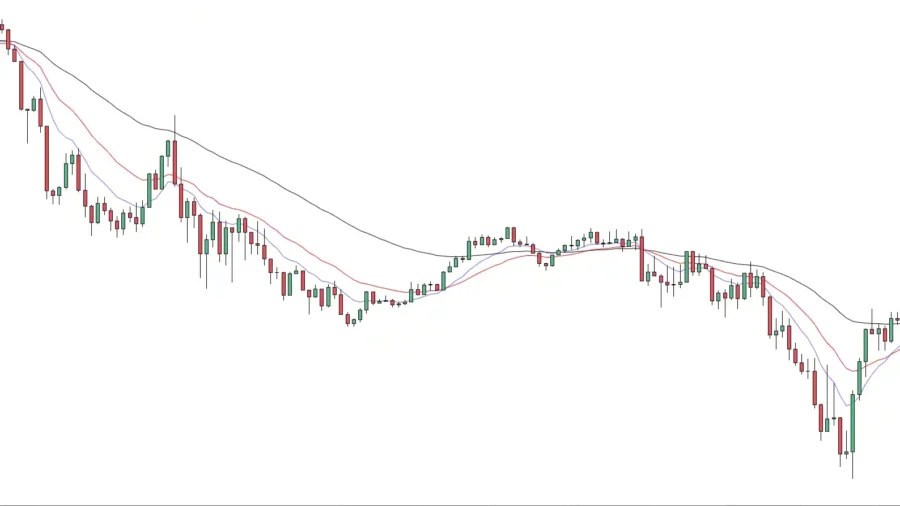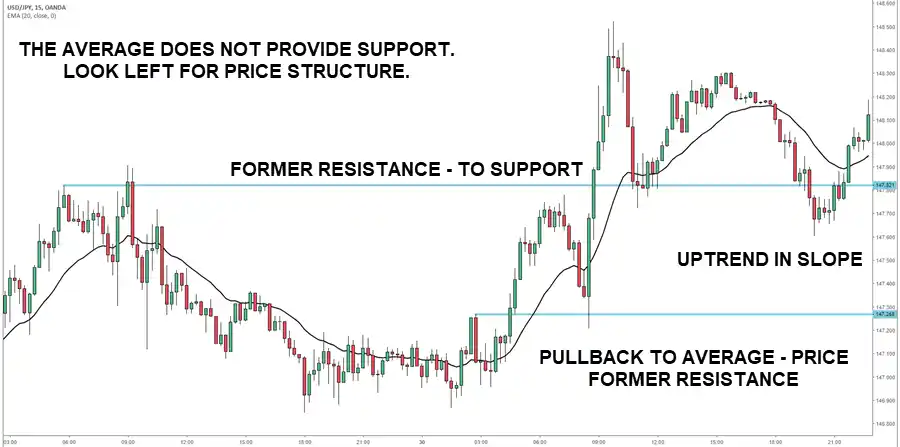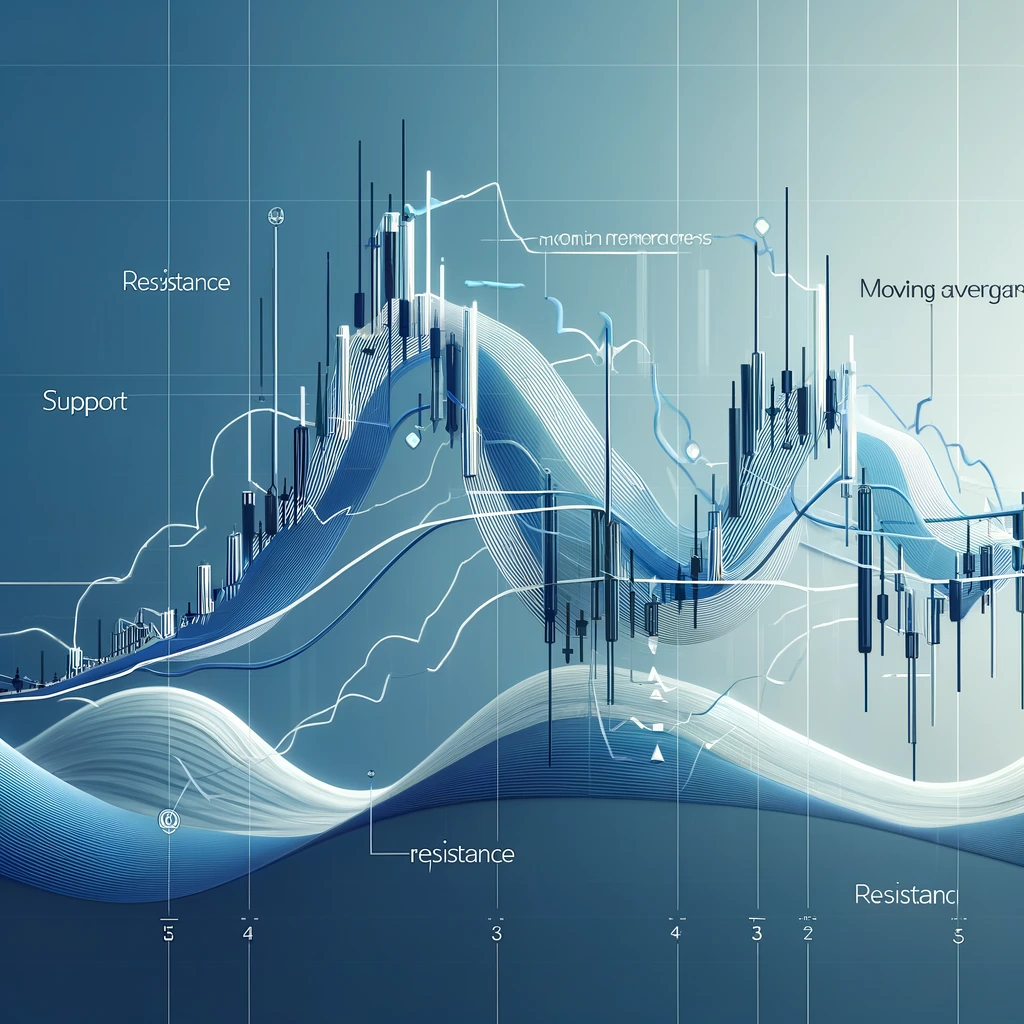Being a forex trader, you want to capture the best possible trades to grow your portfolio. You need to master the art of trading by learning some tools. The moving average is one of the most critical foundational forex market tools. Traders often use it to get a clear market view and identify the trends. Sighting the trend of the market is very essential for day traders. Either you are a day trader or a scalper. A day trader focuses on short-term trading strategies. A scalper makes multiple trades throughout the day. Mastering moving averages on a 15-minute chart is very essential.
The 15-minute chart offers a unique balance to day traders. It may capture the quick movement of the market and filter out ‘noise.’ That can distort the timeframe, which can happen in a shorter timeframe, like a 5-minute chart. Placing the moving average on a 15-minute chart can guide traders through the sharp fluctuations in the market. By smoothing out the price fluctuations and cutting out the market volatility for the intraday. It helps you to focus on the prevailing trend. It also allows a trader to identify a trade’s entry and exit points. By helping identify support and resistance levels and trend reversals.
There are several types of Moving Averages (MA) used in forex. Traders prefer the Simple Moving Average (SMA) and the Exponential Moving Average (EMA). In this guide, we will further discuss.
- Understanding Moving Averages on a 15-Minute Chart
- 15-Minute Chart Moving Average Strategies.
- Tips for Mastering Moving Averages on a 15-Minute Chart
Understanding Moving Averages on a 15-Minute Chart

If you want to be a successful forex trader, you have to master moving averages. What kind of trader are you? This will depend on your financial goals and risk-taking capacities. A short-term trader who wants to gain points in a shorter trading duration must know a 15-minute chart. This chart gives the best trend view of recent price movements. It cancels unnecessary market fluctuations or “noise.”
1. Identifying Trends
- Shorter MAs, like 5 or 10 periods plotted on a 15-minute chart, show immediate price direction.
- You can predict the overall trend by plotting longer MAs, like 50 or 100 periods, on a 15-minute chart.
Did You Know? Suppose you’re trading in a volatile market. You can use shorter MAs to capture quick moves. Traders can use longer MAs to get a smoother view of trend-bypassing noise.
2. Entry and Exits with Crossovers
Bullish Crossover: A shorter MA crossing above a longer MA signals a buy, as it may be an uptrend.
Bearish Crossover: A shorter MA crossing below a longer MA signals a sell, as it may be a downtrend.
*MA= Moving Average
3. Dynamic Support and Resistance
A bounce of the price from MA acts as dynamic support in an uptrend or resistance in a downtrend.
15-Minute Chart Moving Average Strategies

Most forex traders strive to earn profits in a highly volatile market. They have to master the moving average on a 15-minute chart. This chart is quite popular among day traders and scalpers. It captures short-term trends without capturing the ‘noise’ like shorter time frames. It clarifies the traders as they can get a proper sight of the trend and see the bigger picture. Let us see some strategies that traders can use on a 15-minute chart.
1. The Crossover Strategy
- The crossover strategy is quite popular among short-term traders. They want to capitalize on the market’s momentum shifts and trend reversals.
- This strategy involves two moving averages, short-period and long-period MA. The crossover triggers possible buy or sell in the market.
Using Short- and Long-Term MA
- Traders could use short-term moving averages like the 9-period or 15-period EMA. This is to capture a quick price change.
- Long-term moving averages like the 21-period or 50-period EMA. This is to be to check the broader trend.
Note: Traders prefer EMAs (Exponential Moving Average) over SMAs (Simple Moving Average). EMAs respond fast to price changes, while SMAs lag in responding to quick price changes. It seems beneficial for a short-term trade.
How it Works: The Golden Axe
The Buying Opportunity: If the short-term EMA crosses over the long-term EMA, the market triggers a bullish signal indicating upward movement. Traders can buy from here. The trader names this crossover “The Golden Axe.”
The Exit Signal: The Death Cross: The market triggers a bearish signal if the short-term EMA exceeds the long-term EMA. It indicates downward movement. Traders can exit from long trades or enter into a short position. Traders name this crossover as “The Death Cross.”
2. The Trend Following
- A trader needs to follow a trend to execute profitable trades. The 15-minute MA helps a trader in such a way that they cash on short-term trends during a session.
- This strategy uses one or more MAs to identify the direction of the trend. Once the trader determines the trend direction, they can look for entry and exit points.
Moving Averages to Find Trend
- Use a single moving average, for example, the 50 EMA, to identify current market trends. Once a trader identifies the trend, they can build the rest of the strategies.
- You can also use the combination of two moving averages. A 15-period EMA to identify short-term trends. A 50-period EMA for the long-term trend.
Note: Traders prefer EMA over SMA as it is the most suitable to identify short-term trends.
EMA: Exponential Moving Average.
SMA: Simple Moving Average.
Identifying Trends Direction
- Scenario 1: When the price exceeds the 50 EMA, it is an uptrend. If the price is below 50 EMA, it is a downtrend. Open buying positions in an uptrend. Exit from a long position in a downtrend or short-sell.
- Scenario 2: If the 15 EMA is above the 50 EMA, it confirms an uptrend; otherwise, it is a downtrend.
3. Bounce Strategy
- The 15-period MA bounce strategy is for short-term traders. Traders want to benefit from the “bounce” price from a moving average line. This happens during a strong trend.
- In these conditions, the moving average acts as dynamic support or resistance. The price pulls back and “bounces” before continuing in the trend’s direction. The traders want to cash in on this short interval where the price follows a predictable trend.
Steps to Apply Moving Average for Bounce Strategy
Choose the correct moving average: You can choose between moving averages. When capturing short pullbacks and working in a fast-moving market, use the 20 EMA on a 15-minute chart. The 50 EMA is for significant pullbacks and works with slow trends.
Identifying Trend: The price above the moving average is an uptrend; below is a downtrend.
Wait for entry signals. Go for a long entry in an uptrend or a short position in a downtrend.
Exit signal: If you are going for long trades, set a profit target based on the next resistance level. For short trades, look for the following support levels.
Example For Short Trade: Entering in a Short Trade
- Suppose you are trading with a USD/JPY currency pair in a downtrend. Wait until the price rises above or to the 20 EMA.
- Enter a short trade if you see a bearish rejection candle in the 15-minute chart
- Stop Loss: Recent high
- Target: Below the next support level
Example For Long Trade
- Suppose you are trading with a EUR/USD currency pair in an uptrend on a 15-minute chart. Price pulls back to the 20 EMA.
- A bullish, engulfing candle suggests a bounce signal. Enter into a long trade.
- Stop Loss: Below the recent low
- Target: Near the next resistance level.
4. Ribbon Strategy
A 15-period moving average ribbon strategy is another popular short-term strategy. It is generally preferred during short-term trading.
How is a Ribbon Formed?
- In this strategy, traders prefer the exponential moving average. Several EMAs are plotted on a 15-minute chart.
- When plotting these moving averages together, they form a “ribbon.”
- The ribbon provides market insight and reveals market trends. It helps to identify trade entry and exit points based on momentum changes.
Set up a 15-minute Moving Average Ribbon Strategy
For Short EMAs: Traders choose several EMAs from 5, 10, and 15 periods. They are helpful in short-term moves as they react to prices at a good pace.
Medium and Longer EMAs: Traders choose several EMAs from 20, 25, 30, and 35 periods. They show more robust trends and act as support and resistance levels.
Interpreting a ribbon: An uptrend is when all EMAs align and move upward. A downtrend is when all EMAs align and move downward. When shorter EMAs cross above or below longer EMAs, it suggests a trend reversal.
Entry Signals (Buy and Sell): Traders buy when shorter EMAs (5 or 10) cross medium or longer EMAs (20+) upward. You can enter short positions when it happens in a downward direction.
Exit Signals: A shorter EMA triggers an exit signal if it starts to merge or cross the longer EMAs in the opposite direction.
Note for risk management: Set up a tight stop-loss due to high volatility in a 15-minute timeframe.
5. Scalping Strategy
A scalper on a 15-minute chart must be alert to minor price changes and execute multiple trades. Let us discuss how to use a scalping strategy on a 15-minute chart.
Setting Up the Indicators
- You should use two moving averages to identify the trend. To know the short-term trends, you can use a 5-period EMA.
- To verify the general trend, you can use a 15-period EMA.
Tip: Using RSI, you can examine the trend strength and spot traditional reversals. Set RSI to a 14-period. Keep overbought levels at 70 and oversold levels at 30. (RSI is the Relative Strength Index.)
Entry and Exit
- When the 5 EMA crosses over the 15 EMA, this triggers a potential uptrend. To confirm, the RSI must be above 50 or moving upward from oversold levels.
- When the 5 EMA crosses below the 15 EMA, this triggers a potential downtrend. To confirm, the RSI must be below 50 or moving downward from overbought levels.
Risk Management
Stop loss: In case of a buy, keep it below the recent low or above the recent high for a sell.
Risk-reward ratio: Aim for 1:1 or even 1.5:1.
Note: Scalping is effective in high-volume market sessions, like the London and New York sessions.
6. Reversal Strategy
This strategy aims to identify where the current trend may weaken and can change its direction. The reversal points are essential to determining whether to have a profitable trade. Let us discuss the approach for setting a reversal strategy on a 15-minute chart.
Setting Up the Indicators
Setting up RSI: Traders need to set a 14-period with 70 as overbought and 30 as oversold. The asset is overbought when the RSI exceeds 70 levels, signaling a downtrend reversal. The asset may be oversold if the RSI is below 30, triggering an uptrend reversal.
Moving Averages: If the price crosses the 50-period and 200-period moving averages, it helps identify a trend reversal.
Candlestick Patterns: Find a Doji, Hammer, or Engulfing pattern near support or resistance. If you do, it suggests a potential trend reversal.
Entry and Exit Points
- It is an oversold condition if the price breaches critical support with the RSI below 30. You can confirm it with a bullish candlestick pattern like a hammer or engulfing.
- It is an overbought condition if the price reaches key resistance with the RSI above 70. You can confirm it with a bearish candlestick pattern like a shooting star or a bearish engulfing.
Risk Management
Stop-loss: For Buy: Below the support level. For Sell: Above the resistance level.
Tips for Mastering Moving Averages on a 15-Minute Chart
Moving Averages 15m Chart
Choose Right MAs EMA 9, 21, 50
Look for Crossovers
Support & Resistance
Other Indicators
MA as Trend Filter
Adjust for Volatility
Popular combinations for short-term trading
Golden/Death Cross Entry/Exit signals
MAs often act as dynamic S/R levels
RSI, MACD for confirmation
Trade with trend direction
Adapt periods to market conditions
As a trader, you need to decide on your trading style. If short-term trading aligns with your financial goals and risk tolerance. You must master specific strategies, like moving averages. Mastering 15-minute moving averages is a great way to be an aggressive short-term buyer. Let me provide some tips to you.
1. Choose the Right Moving Averages
- Use short-term MAs to capture quick price changes. You can choose between a 5-period or a 10-period.
- When you want to check the broader market trend, pair short-term MA with long-term MA. It can be a 50-period or a 100-period.
2. Look for Crossovers
- Bullish Crossover: As the short-term MA crosses above the long-term MA. It triggers an uptrend.
- Bearish Crossover: If the short-term MA crosses below the long-term MA. It triggers a downtrend.
3. Combine with Support and Resistance
- For successful trade, use MAs as dynamic support and resistance.
- There are two cases. If the price bounces off MA, it signals continuation. A break may signal a possible reversal.
4. Other Indicators and Adjust for Volatility
- For confirmation of MA signals, combine them with RSI and MACD indicators.
- RSI is the Relative Strength Index. MACD is the Moving Average Convergence Divergence.
5. MAs as a Trend Filter
- This is the most important tip. Trade in the direction of the longer-term MA.
- Buy if the 50 MA is trending upward.
Conclusion
In this blog, we have discussed the understanding of moving averages on a 15-minute chart. To be a successful forex trader, you must master moving averages. You must find a trading style that suits you and meets your goals. Remember your risk tolerance. To be a short-term trader, you need to master a 15-minute chart. We have discussed many strategies. If you follow them with great dedication, you can become a forex god.
Frequently Asked Questions
There are six possible steps to reading a 15-minute chart.
1. Identify the current trend.
2. Look for support and resistance levels.
3. Are technical indicators confirming the current trend or suggesting a reversal?
4. Look for chat patterns like heads and shoulders, flags, or triangles. Are they favouring the trend or suggesting a reversal?
5. What is the trading volume?
6. Look for setting entry and exit points.
The 20-period Exponential Moving Average (EMA) is an excellent tool for use on a 15-minute chart. The tool can help you trade by showing short-term price movements in the current trend.
A trader uses this strategy to find an asset. It must have a big price movement within 15 minutes. Once they identify it, they use this information for timely entry and exit in the trade.
According to Opening Range Breakout (ORB), the day’s high or low is often set within the first 15 minutes of trading. The traders need to mark a price band within the highest and lowest prices of first 15-minute period. A trader will buy if the price moves above the band and sell if the price moves below the band.


